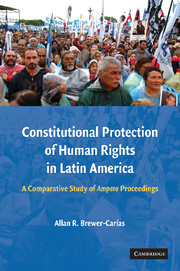 Constitutional Protection of Human Rights in Latin America
Constitutional Protection of Human Rights in Latin America Book contents
- Frontmatter
- Contents
- INTRODUCTION
- PART ONE THE CONSTITUTIONAL AND INTERNATIONAL DECLARATION OF HUMAN RIGHTS AND ITS JUDICIAL GUARANTIES
- PART TWO THE AMPARO AS A LATIN AMERICAN CONSTITUTIONAL AND INTERNATIONAL LAW INSTITUTION
- PART THREE THE INJURED PARTY AND THE CONSTITUTIONAL RIGHTS PROTECTED BY MEANS OF THE AMPARO PROCEEDING
- PART FOUR THE INJURY, THE INJURING PARTY AND THE INJURING ACTS OR OMISSIONS IN THE AMPARO PROCEEDING
- Chapter Twelve The General Conditions of the Injury (Harms and Threats)
- Chapter Thirteen The Reparable Character of the Harms and the Restorative Character of the Amparo Proceeding
- Chapter Fourteen The Imminent Character of the Threats and the Preventive Character of the Amparo Proceeding
- Chapter Fourteen The Injuring Party: The Defendant (Public Entities or Private Individuals)
- Chapter Sixteen The Injuring Public Actions and Omissions of Public Authorities Causing the Harms or the Threats
- PART FIVE THE EXTRAORDINARY CHARACTER OF THE AMPARO PROCEEDING
- CONCLUSION
- APPENDIX A List of Latin American Constitutions
- APPENDIX B List of Latin American Amparo Laws (Statutes)
- INDEX
Chapter Thirteen - The Reparable Character of the Harms and the Restorative Character of the Amparo Proceeding
Published online by Cambridge University Press: 08 August 2009
- Frontmatter
- Contents
- INTRODUCTION
- PART ONE THE CONSTITUTIONAL AND INTERNATIONAL DECLARATION OF HUMAN RIGHTS AND ITS JUDICIAL GUARANTIES
- PART TWO THE AMPARO AS A LATIN AMERICAN CONSTITUTIONAL AND INTERNATIONAL LAW INSTITUTION
- PART THREE THE INJURED PARTY AND THE CONSTITUTIONAL RIGHTS PROTECTED BY MEANS OF THE AMPARO PROCEEDING
- PART FOUR THE INJURY, THE INJURING PARTY AND THE INJURING ACTS OR OMISSIONS IN THE AMPARO PROCEEDING
- Chapter Twelve The General Conditions of the Injury (Harms and Threats)
- Chapter Thirteen The Reparable Character of the Harms and the Restorative Character of the Amparo Proceeding
- Chapter Fourteen The Imminent Character of the Threats and the Preventive Character of the Amparo Proceeding
- Chapter Fourteen The Injuring Party: The Defendant (Public Entities or Private Individuals)
- Chapter Sixteen The Injuring Public Actions and Omissions of Public Authorities Causing the Harms or the Threats
- PART FIVE THE EXTRAORDINARY CHARACTER OF THE AMPARO PROCEEDING
- CONCLUSION
- APPENDIX A List of Latin American Constitutions
- APPENDIX B List of Latin American Amparo Laws (Statutes)
- INDEX
Summary
As mentioned, the injury inflicted upon constitutional rights in order to the filing of an amparo action, can be the result of harms or threats, which must fulfill the general conditions aforementioned.
In addition, two other conditions must fulfill the injury, depending on being harms or threats. If it is a harm inflicted on the persons' rights, it has to be a reparable one, the amparo proceeding seeking to restore the enjoyment of the right, having a restorative character; but if the injury is a threat caused upon the right, it must be imminent, the amparo tending to prevent or impede the violation to occur, having a preventive character.
THE RESTORATIVE CHARACTER OF THE AMPARO AGAINST HARMS
In effect, in case of harms, the amparo proceeding seeks to restore the enjoyment of the plaintiff's injured right, reestablishing the situation existing when the right was harmed, by eliminating or suspending, if necessary, the detrimental act or fact.
In this regard, the amparo action also has similarities with the reparative injunctions in the United States, which seeks to eliminate the effects of a past wrong or to compel the defendant to engage in a course of action that seeks to correct those effects.
- Type
- Chapter
- Information
- Constitutional Protection of Human Rights in Latin AmericaA Comparative Study of Amparo Proceedings, pp. 276 - 282Publisher: Cambridge University PressPrint publication year: 2008


